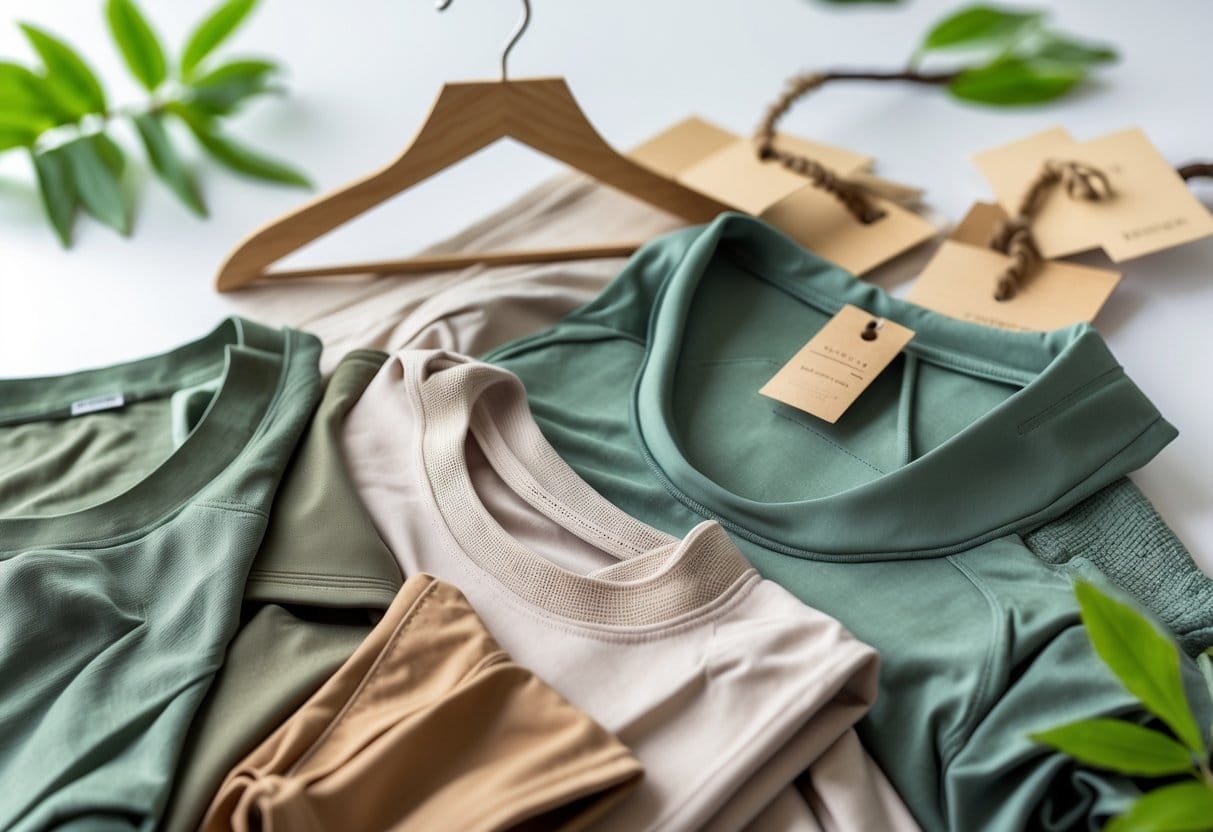Sportswear Trends: Shaping the Future of Activewear
Sportswear Trends in 2025 is shaped by a clear focus on sustainability, technology, and inclusivity. Consumers now expect activewear that not only supports their performance but also aligns with their environmental values. Brands are responding with eco-friendly materials and smarter designs that enhance comfort and function.

The biggest changes in sportswear combine wearable tech, versatile styles, and gender-neutral options to meet the needs of a wide range of users. This means clothing that adapts to the wearer’s activity while offering style suitable for both workouts and everyday use. Innovation in fabrics and fit is making athletic apparel more effective and comfortable than ever.
At the same time, customization and clean, minimalist designs are becoming more popular, reflecting a shift toward personalized and timeless sportswear. These trends are redefining how people dress for fitness and leisure, blending performance with fashion.
Key Takeaways
- Sportswear focuses on eco-friendly materials and smarter performance features.
- Versatile, gender-neutral designs meet broader consumer needs.
- Personalization and minimalist style define modern activewear.
Sustainable Fabrics and Eco-Friendly Materials

The sportswear industry is shifting toward eco-friendly options that reduce environmental harm. This change involves using innovative fabrics and recycled materials designed to maintain performance while supporting sustainability.
Growth of Sustainable Sportswear trends
The demand for sustainable sportswear has grown rapidly in recent years. Consumers, especially younger generations, are choosing brands that prioritize eco-friendly materials and transparent production processes. This trend pushes companies to adopt greener practices and invest in new fabric technologies.
Major brands are launching collections focused on reducing waste and carbon emissions. Events and athlete endorsements also highlight the importance of sustainability. As a result, sustainable sportswear is becoming a key part of the market rather than a niche.
Popular Eco-Friendly Materials in Activewear
Activewear now often incorporates materials like organic cotton, bamboo blends, and TENCEL™. Organic cotton is grown without pesticides, making it better for soil and water quality. Bamboo is naturally antibacterial and moisture-wicking, which helps athletes stay comfortable.
TENCEL™ and modal fabrics come from sustainably harvested wood pulp. They are soft, breathable, and biodegradable, blending comfort and environmental care. These materials are chosen not only for their green credentials but also for durability and fit.
Many brands also use upcycled ocean plastics to create leggings and shoes. This practice reduces marine waste and raises awareness of pollution.
Recycled Polyester and Organic Cotton Choices
Recycled polyester (rPET) is a popular fabric made from plastic bottles and other post-consumer waste. It helps keep plastics out of landfills and oceans while delivering strong performance qualities like stretch and moisture-wicking.
Organic cotton is valued for its low environmental footprint. It uses less water and eliminates harmful chemicals compared to conventional cotton. Sportswear made from organic cotton often feels softer and is breathable, making it suitable for training gear.
Both materials support sustainability goals by lowering resource use and pollution. Sportswear brands choosing recycled polyester and organic cotton respond directly to consumer demand for responsible fashion.
Smart Technology and Wearable Innovation

Advances in sportswear focus on integrating technology with fabrics to boost athlete performance and health. This includes clothing equipped with sensors that track physical data and materials designed to improve comfort and durability. The combination of high-tech features and smart designs is reshaping how athletes train and recover.
Wearable Technology in Sportswear
Wearable technology in sportswear goes beyond simple fitness trackers. It includes smart garments with embedded sensors that monitor muscle activity and body movement. These devices provide real-time feedback to help athletes adjust their form and avoid injuries.
Smart sportswear also links with mobile apps and other devices to deliver personalized coaching. This connectivity turns regular clothing into interactive gear that supports training goals efficiently.
Innovations often use lightweight, flexible materials to keep athletes comfortable while ensuring accuracy. The technology is designed to be unobtrusive, supporting natural movement during intense physical activity.
Smart Fabrics and Performance Monitoring in Sportswear Trends
Smart fabrics combine textiles with electronic components to monitor performance metrics directly from the skin. These fabrics can detect sweat levels, temperature, and strain, giving deeper insight into an athlete’s condition during workouts.
Performance fabrics often include breathable materials with stretchable circuits, allowing sensors to function without limiting movement. Many manufacturers prioritize sustainability by using recycled and plant-based fibers in these products.
The integration of smart fabrics helps track athletic effort and environmental factors, allowing for better management of fatigue and recovery. This real-time data guides athletes in maintaining peak performance safely.
Heart Rate Monitoring and Biometric Tracking
Heart rate monitoring is a central feature in modern smart sportswear. Embedded sensors continuously measure heart activity, enabling users to track intensity and recovery more precisely than traditional devices.
Biometric tracking goes further by including metrics such as oxygen levels, muscle stress, and hydration status. Together, these features support comprehensive health monitoring during training and competition.
Athletes can receive alerts about their physical limits, helping prevent overexertion and related injuries. These tools are especially valuable in endurance and high-impact sports, where managing physiological stress is critical.
Rise of Athleisure and Everyday Versatility

Athleisure has changed how people wear sportswear, making it a main part of daily fashion. This style mixes comfort with style and fits many situations beyond just exercise. Its ability to move easily between different settings appeals to a wide range of consumers.
Athleisure Trend in Modern Sportswear
Athleisure has become a major part of modern sportswear by blending athletic performance with casual fashion. Brands like Nike and Lululemon create garments that use moisture-wicking fabrics and stretchy materials to support active use.
This trend focuses not only on function but also on stylish design. High-waisted leggings, matching sets, and oversized hoodies are popular pieces that balance comfort and appearance. The rise of digital influencers showcasing athleisure outfits has helped propel the trend into mainstream culture.
Seamless Transition from Gym to Street
Athleisure wear is designed to move easily from workout environments to everyday life. The clothing combines practical features like breathable fabrics and hidden pockets with stylish cuts and colors.
This versatility allows people to wear the same outfit to the gym, run errands, or meet friends. It reflects changing lifestyles where convenience and multi-use items are priorities. Consumers want apparel that fits both active routines and social settings without needing to change clothes.
Versatile Athleisure for All Occasions
Versatile athleisure fits diverse occasions, from casual office settings to social outings. Many pieces are made with sustainable materials like recycled polyester and organic cotton, appealing to eco-conscious buyers.
Luxury brands are collaborating with sportswear companies to offer options that mix high fashion with athletic comfort. This shift broadens athleisure’s appeal to different age groups and style preferences. Features such as adjustable fits and moisture control cater to varied needs, making athleisure wear practical for both relaxed and semi-formal occasions.
Performance-Driven and Compression Apparel

Sportswear in 2025 focuses on improving how athletes perform and recover. This includes using compression wear to support muscles and advanced fabrics that enhance comfort and durability. These products help athletes do better during exercise and recover faster afterward.
Benefits of Compression Wear
Compression wear is designed to apply pressure to muscles, improving blood flow. This helps reduce muscle vibration during activity, which can lower fatigue and prevent injuries. Many athletes use compression shirts and leggings because they support muscle stability.
These garments also help speed up recovery by promoting quicker removal of metabolic waste from muscles. Users often notice less soreness after workouts. Beyond performance, compression wear is popular for its tight fit and sleek look, making it easy to wear outside the gym.
Compression clothing’s ability to balance comfort and performance makes it a key trend. Its growing popularity relates to its dual role in enhancing exercise outcomes and everyday wearability.
Advancements in Performance Fabrics
Performance fabrics have changed the way sportswear supports athletes. High-tech materials are now engineered to be lightweight, breathable, and moisture-wicking to keep the wearer cool and dry.
Many fabrics also include antimicrobial and UV protection features. These help prevent odors and protect skin during outdoor activities. Some materials even adapt to temperature changes, offering better comfort in different climates.
Manufacturers use sustainable fibers alongside synthetic ones, balancing environmental impact with fabric performance. This mix improves durability while meeting consumer demand for responsible production.
Using these materials allows sportswear to be more functional and stylish, meeting the needs of athletes and everyday users alike.
Gender-Neutral and Inclusive Sportswear

The sportswear industry is changing to include designs that work for everyone, regardless of gender or body type. This shift involves creating styles that feel comfortable and functional while breaking old ideas about who certain clothes are for. Brands now focus on fit, fabric, and color choices that suit all people, expanding who can find gear that fits their needs.
Shift Toward Universal Designs
Universal designs in sportswear use relaxed fits and adaptive features to suit a wide range of bodies. Seams are adjusted to avoid emphasizing typical gender-specific shapes like busts or hips. Fabrics stretch equally across all areas for consistent comfort and support.
Colors and styles move away from traditional gendered codes. Neutral tones like earth shades, charcoal, and sage appeal broadly. Silhouettes such as boxy hoodies and drop-crotch joggers offer versatile looks that anyone can wear.
Many top brands adopt these elements to reach more customers. Features like two-way zippers and adjustable toggles make clothing easier to customize. This approach not only meets demand for inclusivity but also streamlines production by using crossover designs.
Inclusive Sizing and Fit
Inclusive sizing in sportswear means offering a broad range of sizes, from petite to plus, with designs adjusted for different shapes. This helps customers find activewear that fits well and supports movement, no matter their body type.
Adaptive fit guides help brands create samples that accommodate variations in body curves and proportions. Four-way stretch fabrics and soft, body-neutral materials enhance comfort and flexibility.
This focus on sizing also reflects growing awareness of diversity in athletic ability and identity. Providing options that work for everyone increases access to sports and fitness, aligning brands with modern values and expanding their markets.
Design, Customization, and Aesthetic Innovations

Sportswear design is evolving rapidly with new styles and technology driving fresh looks and improved performance. Advances in materials and design methods allow brands to create eye-catching gear that fits individual needs and reflects modern tastes.
Bold Colors and Futuristic Aesthetics
Bold colors are defining current sportswear trends. Bright neons, deep metallics, and contrasting color blocks are common in activewear collections. These choices help athletes stand out while giving a modern, futuristic vibe to their outfits.
Designers also use high-tech materials to create sleek shapes and sharp lines. Reflective fabrics and glossy finishes add a tech-inspired look. This focus on aesthetics does not reduce functionality—fabrics remain breathable, moisture-wicking, and stretchable.
The combination of bold colors with advanced material technology helps clothes perform well during workouts while making a clear style statement. This approach appeals to athletes and casual wearers who want gear that looks fresh and high-performance.
Personalization and Customizable Options
Customization is a major trend in sportswear, letting consumers tailor products to their tastes and needs. Brands now offer options like adjustable fits, personalized graphics, and a wide range of sizes.
Customization extends to footwear and outerwear, with personalized colors, names, or logos becoming more common. High-tech tools, including digital design interfaces and 3D printing, help brands deliver precise, made-to-order items.
These options improve wearer satisfaction by offering better fit and unique style. Custom gear also fosters a stronger personal connection to products, encouraging loyalty and repeat purchases. This trend reflects growing demand for individuality in athletic wear markets.
Frequently Asked Questions
Sportswear Trends today emphasizes eco-friendly materials, smart technology, and adaptable designs. Performance and style work together through fabric choices, color trends, and innovative features. The market also reflects changes driven by consumer preferences and collaborations in fashion.
What are the latest sustainable materials being used in sportswear?
Recycled polyester and organic cotton are widely used to reduce environmental impact. Bamboo fiber is gaining attention for its breathability and natural antibacterial properties. Brands focus on sourcing materials responsibly to meet demand for eco-conscious activewear.
How has technology integration in sportswear advanced in recent years?
Sportswear now includes AI-powered sensors that track heart rate and provide real-time feedback. Temperature-regulating fabrics help maintain comfort during workouts. Wearables and clothing often sync with smart devices to optimize training and recovery.
What are the current popular color schemes in sportswear design?
Neutral colors like black, gray, and beige dominate minimalist collections. These shades support versatile styling and a clean look. Some lines also blend vintage-inspired colors from the 80s and 90s with modern touches.
Which sportswear features are most important for performance enhancement?
Compression wear boosts blood flow, reduces muscle fatigue, and speeds recovery. Moisture-wicking fabrics keep athletes dry. Durability and breathability remain key for long-lasting sportswear that supports various activities.
How is the athleisure trend influencing traditional sportswear?
Athleisure blends comfort with everyday styling, making sportswear suitable beyond workouts. This trend pushes brands to design clothing that transitions smoothly from exercise to casual wear. Comfort and style are equally prioritized.
What collaborations between fashion designers and sportswear brands are currently trending?
Collaborations focus on merging high fashion with functional sportswear. Limited-edition collections often feature unique designs and updated vintage styles. These partnerships attract diverse customers and introduce fresh aesthetics to performance gear.







